Utnapishtim And The Babylonian Flood Story
Ellen Lloyd - AncientPages.com - The ancient story of the great Flood has been re-told worldwide. We find accounts of the event among many ancient cultures all across the world. They all have myths and legends describing a time in the distant past when a horrifying Deluge wiped almost all life on Earth.
The story of Noah’s Ark is not just a Biblical story. Noah was known under a different name in India, among ancient Egyptians and Native Americans, to mention a few cultures.
The life of Utnapishtim and the Babylonian Flood Story are described in the Epic of Gilgamesh. Just like Noah, Utnapishtim is the survivor of the Deluge. Gilgamesh is the semi-mythic King of Uruk best known from The Epic of Gilgamesh (written c. 2150-1400 BCE) the great Sumerian/Babylonian poetic work.
Memories of an antediluvian (pre-flood) period were preserved throughout Mesopotamia: The Sumerian King List includes antediluvian kings, and reliefs of antediluvian sages known as apkallu, winged and bird-headed creatures lined the walls of Assyrian palaces and remain one of the most iconic forms of Mesopotamian art to this day.
The Chaldean Flood Tablets from the city of Ur in what is now Southern Iraq contain a story that describes how the Babylonian god Enlil had been bothered by the incessant noise generated by humans. To punish people he sends a Deluge to wipe out life on the planet.
The Sumerian god Enki, later known as Ea in Akkadian and Babylonian mythology went against the decision of the rest of the gods and ordered Utnapishtim to abandon his worldly possessions and create a huge ship to be called The Preserver of Life.
The ship was made of solid timber so that the rays of Shamash (the Sun) would not shine in, and of equal dimensions in length and width. God Enki assisted with the design and construction of The Preserver of Life. The building of the ship took five days. The ship’s interior had seven floors, each floor divided into 9 sections, finishing the ark fully on the seventh day.
Knowing that the oncoming flood would wipe out all life on Earth, Utnapishtim was told to quickly take his wife, relatives, some of the villagers, animals along with various grains and seeds and board the ship. The entrance to the ship was sealed once everyone had boarded it.
Utnapishtim spent 12 days on The Preserver of Life. When he finally felt it was safe to open the hatch, he saw the slopes of Mount Nisir, supposedly the mountain known today as Pir Omar near the city Sulaymaniyah in Iraqi Kurdistan. Researchers have speculated the name may mean "Mount of Salvation".
He waited seven days before he sent a dove out to see if the water had receded, but the dove could not find anything but water and returned. Utnapishtim repeated the procedure. Next time he sent out a swallow, and just as before, it returned, having found nothing. Finally, Utnapishtim sent out a raven, and the raven saw that the waters had receded, so it circled around but did not return. Utnapishtim then set all the animals free and made a sacrifice to the gods.
The gods were happy he had obeyed their wish and preserved the seed of man. In return for his trust and loyalty, the gods gave him and his wife the gift of immortality and a place among the heavenly gods.
The story of the quest for immortality is explored in the Epic of Gilgamesh.
Gilgamesh, who is devasted by the death of his brother Enkidu sets out on a series of journeys to search for his ancestor Utnapishtim who lives at the mouth of the rivers and has been given eternal life. Gilgamesh fears his own death and searches for a way to preserve his life forever.
Utnapishtim tells Gilgamesh to abandon his search for immortality but tells him that there is a place where the Flower of Immortality is located and that it can restore his youth and the youth of others. Gilgamesh gets the flower and leaves for home with the boatman, but along the way, a serpent in the pool steals the flower and it is lost. An interesting symbol of evil similar to the bible is the snake or the serpent.
Left: The Babylonian Flood Tablet translated by George Smith in the mid/late 19th century. The British Museum.
Right: The so-called Ark Tablet, recently translated by Irving Finkel, is an Old Babylonian (1900-1700 B.C.E.) account of the flood in which the god Enki instructs Atrahasis—the Babylonian Noah—on how to build an ark.
Gilgamesh returned home to the city of Uruk, having abandoned hope of either immortality or renewed youth.
The tale of Utnapishtim and the Earth before the Great Flood would have all been forgotten had it not been for his chance of acquaintance with the hero Gilgamesh.
The Epic of Gilgamesh has been of interest to Christians ever since its discovery in the mid-nineteenth century in the ruins of the great library at Nineveh, with its account of a universal flood with significant parallels to the Flood of Noah's day.
While there are great similarities between the Biblical and Babylonian flood stories, there are also certain fundamental differences.
Whether the Deluge story is based on something that really took place or is just a myth remains unknown, but there are scientists who are convinced the Great Flood and Noah’s Ark were real events.
Written by Ellen Lloyd – AncientPages.com
Copyright © AncientPages.com & Ellen Lloyd All rights reserved. This material may not be published, broadcast, rewritten or redistributed in whole or part without the express written permission of AncientPages.com and Ellen Lloyd
More From Ancient Pages
-
 Forgotten And Overgrown Step Pyramid Of Koh Ker – Ancient Memory Of The Khmer Empire
Featured Stories | Apr 19, 2017
Forgotten And Overgrown Step Pyramid Of Koh Ker – Ancient Memory Of The Khmer Empire
Featured Stories | Apr 19, 2017 -
 Mystery Of The Lost Biblical Kadesh Where Moses Was Punished By God
Biblical Mysteries | Oct 17, 2017
Mystery Of The Lost Biblical Kadesh Where Moses Was Punished By God
Biblical Mysteries | Oct 17, 2017 -
 Callanish Stone Complex: Sacred Place On The Isle Of Lewis In Scotland
Civilizations | Nov 26, 2018
Callanish Stone Complex: Sacred Place On The Isle Of Lewis In Scotland
Civilizations | Nov 26, 2018 -
 On This Day In History: Battle Of Langside Was Fought – On May 13, 1568
News | May 13, 2016
On This Day In History: Battle Of Langside Was Fought – On May 13, 1568
News | May 13, 2016 -
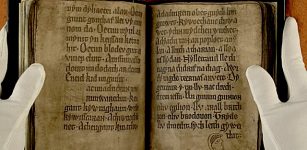 13th Century Black Book Of Carmarthen: Erased Poetry And Ghostly Faces Revealed By UV Light
Artifacts | Apr 4, 2015
13th Century Black Book Of Carmarthen: Erased Poetry And Ghostly Faces Revealed By UV Light
Artifacts | Apr 4, 2015 -
 Cruithne: Legendary King, His Seven Sons And The First Celtic Tribe That Inhabited British Isles
Celtic Mythology | May 27, 2023
Cruithne: Legendary King, His Seven Sons And The First Celtic Tribe That Inhabited British Isles
Celtic Mythology | May 27, 2023 -
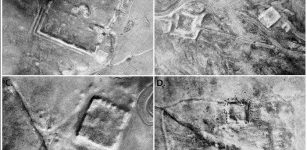 Hundreds Of Undiscovered Roman Forts Revealed By Spy Satellites
Archaeology | Oct 27, 2023
Hundreds Of Undiscovered Roman Forts Revealed By Spy Satellites
Archaeology | Oct 27, 2023 -
 Unique Over 1,000-Year-Old ‘Telephone’ Invented By A Lost Forgotten Civilization With No Written Language
Civilizations | Aug 24, 2018
Unique Over 1,000-Year-Old ‘Telephone’ Invented By A Lost Forgotten Civilization With No Written Language
Civilizations | Aug 24, 2018 -
 Tragic Reign Of Caterina Cornaro – The Last Queen Of Cyprus And Patron Of The Arts
Featured Stories | Jul 4, 2019
Tragic Reign Of Caterina Cornaro – The Last Queen Of Cyprus And Patron Of The Arts
Featured Stories | Jul 4, 2019 -
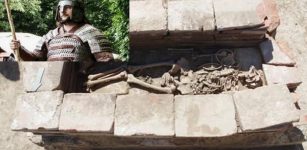 Rare Discovery: Remains Of An Avar Warrior And A Belt Unearthed In Vinkovci, Croatia
Archaeology | May 3, 2020
Rare Discovery: Remains Of An Avar Warrior And A Belt Unearthed In Vinkovci, Croatia
Archaeology | May 3, 2020 -
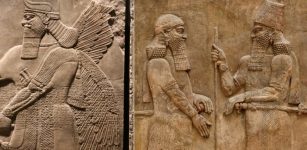 Treasure Trove Of Assyrian Kings Found In Tunnels Excavated And Plundered By Terrorists
Archaeology | Apr 20, 2020
Treasure Trove Of Assyrian Kings Found In Tunnels Excavated And Plundered By Terrorists
Archaeology | Apr 20, 2020 -
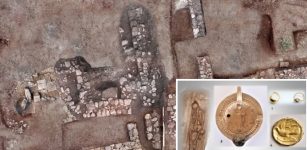 Ruins Of Long-Lost Ancient City Of Tenea Built By Trojans Discovered
Archaeology | Nov 21, 2018
Ruins Of Long-Lost Ancient City Of Tenea Built By Trojans Discovered
Archaeology | Nov 21, 2018 -
 Ancient Marble Statue Of Sphinx Discovered In Tang Dynasty Tomb
Archaeology | Dec 16, 2015
Ancient Marble Statue Of Sphinx Discovered In Tang Dynasty Tomb
Archaeology | Dec 16, 2015 -
 Yak Milk Consumption Among Mongol Empire Elites – New Study
Archaeology | Apr 1, 2023
Yak Milk Consumption Among Mongol Empire Elites – New Study
Archaeology | Apr 1, 2023 -
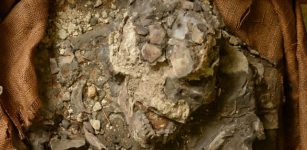 Extraordinary 6,500-Year-Old “Noah” Skeleton Re-Discovered – A Survivor Of The Great Flood Hidden In Museum
Civilizations | Aug 6, 2014
Extraordinary 6,500-Year-Old “Noah” Skeleton Re-Discovered – A Survivor Of The Great Flood Hidden In Museum
Civilizations | Aug 6, 2014 -
 Human Footprints Of People Who Used Caves Of Ojo Guareña, Burgos 4600 Years Ago
Archaeology | Mar 11, 2021
Human Footprints Of People Who Used Caves Of Ojo Guareña, Burgos 4600 Years Ago
Archaeology | Mar 11, 2021 -
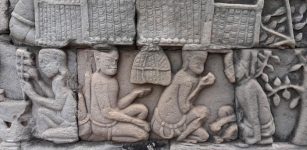 What Can The Fate Of Ancient Cities Teach Us About Surviving Climate Change
Archaeology | Oct 1, 2021
What Can The Fate Of Ancient Cities Teach Us About Surviving Climate Change
Archaeology | Oct 1, 2021 -
 Unique Sword Discovered In Mysterious Pre-Viking Tomb In Uppsala, Sweden
Archaeology | Sep 2, 2019
Unique Sword Discovered In Mysterious Pre-Viking Tomb In Uppsala, Sweden
Archaeology | Sep 2, 2019 -
 Could Aztec Innovative ‘Chinampas’ – ‘Floating Islands’ Help Modern Farmers?
Archaeology | Nov 4, 2019
Could Aztec Innovative ‘Chinampas’ – ‘Floating Islands’ Help Modern Farmers?
Archaeology | Nov 4, 2019 -
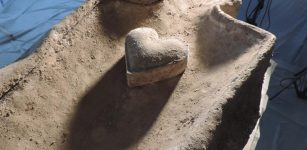 Remarkable discovery: Ancient coffins reveal centuries-old secrets of French nobility
News | Sep 1, 2015
Remarkable discovery: Ancient coffins reveal centuries-old secrets of French nobility
News | Sep 1, 2015



